Study of Ion-Assisted E-Beam Evaporation Coating Process on Chirped Mirrors
Abstract
:1. Introduction
2. Optics Theory in Thin Film
2.1. Calculation of Dispersion
2.2. Thin Film Theory
2.3. Mirror Dispersion
3. Optical Miror Design
3.1. Merit Function
3.2. Needle Optimization
3.3. Mirror Design
4. Design Verifications and Experimental Results
5. Conclusions
Author Contributions
Funding
Institutional Review Board Statement
Informed Consent Statement
Data Availability Statement
Acknowledgments
Conflicts of Interest
References
- Sugioka, K.; Cheng, Y. Ultrafast lasers—Reliable tools for advanced materials processing. Light Sci. Appl. 2014, 3, e149. [Google Scholar] [CrossRef]
- Phillips, K.C.; Gandhi, H.H.; Mazur, E.; Sundaram, S. Ultrafast laser processing of materials: A review. Adv. Opt. Photonics 2015, 7, 684–712. [Google Scholar] [CrossRef]
- Jena, S.; Tokas, R.B.; Sakar, P.; Misal, J.S.; Maidul Haque, S.; Rao, K.D.; Thakur, S.; Sshoo, N.K. Omnidirectional photonic band gap in magnetron sputtered TiO2/SiO2 one dimensional photonic crystal. Thin Solid Films 2016, 599, 138–144. [Google Scholar] [CrossRef]
- Szipöcs, R.; Ferencz, K.; Spielmann, C.; Krausz, F. Chirped multilayer coatings for broadband dispersion control in femtosecond lasers. Opt. Lett. 1994, 19, 201–203. [Google Scholar] [CrossRef]
- Amochkina, T.; Trubetskov, M. Designing broadband dispersive mirrors in the mid-infrared spectral range: A theoretical study. Appl. Opt. 2023, 62, B63–B72. [Google Scholar] [CrossRef]
- Grigoriev, F.G.; Sulimov, V.B.; Tikhonaravov, A.V. Atomistic simulation of the ion-assisted deposition of silicon dioxide thin film. Nanomaterials 2022, 12, 3242. [Google Scholar] [CrossRef] [PubMed]
- Baumeister, P. Design of multilayer filters by successive approximations. J. Opt. Soc. Am. 1958, 48, 955–958. [Google Scholar] [CrossRef]
- Ariza-Flores, A.D.; Gaggero-Sager, L.M.; Agarwal, V. White metal-like omnidirectional mirror from porous silicon dielectric multilayers. Appl. Phys. Lett. 2012, 101, 03119. [Google Scholar] [CrossRef]
- Dems, M.; Wnuk, P.; Wasylczyk, P.; Zinkiewicz, L.; Wojcik-Jedlinska, A.; Reginski, K.; Hejduk, K.; Jasik, A. Optimization of broadband semiconductor chirped mirrors with genetic algorithm. Appl. Phys. B 2016, 122, 266. [Google Scholar] [CrossRef]
- Ortiz-Vazquez, E.; Lujan-Cabrera, I.A.; Isaza, C.; Rizzo-Sierra, J.A.; Ramirez-Gutierrez, C.F. Design of broadband modulated one-dimensional photonic crystal based on porous silicon using evolutionary search. Optik 2022, 260, 169002. [Google Scholar] [CrossRef]
- Tikhonravov, A.V. Synthesis of optical coatings using optimality conditions. Vestn. MGU Phys. Astron. Ser. 1982, 23, 91–93. [Google Scholar]
- Tikhonravov, A.V.; Trubetskov, M.K.; DeBell, G.W. Application of the needle optimization technique to the design of optical coatings. Appl. Opt. 1996, 35, 5493–5508. [Google Scholar] [CrossRef] [PubMed]
- Tikhonravov, A.V.; Trubetskov, M.K.; DeBell, G.W. Optical coating design approaches based on the needle optimization technique. Appl. Opt. 2007, 46, 704–710. [Google Scholar] [CrossRef] [PubMed]
- Furman, S.A.; Tikhonravov, A.V. Basics of Optics of Multilayer Systems; Atlantica Séguier Frontieres: Biarritz, France, 1992. [Google Scholar]
- Larouche, S.; Martinu, L. OpenFilters: Open-source software for the design, optimization, and synthesis of optical filters. Appl. Opt. 2008, 47, C219–C230. [Google Scholar] [CrossRef] [PubMed]
- Pervak, V.; Razskazovskaya, O.; Angelov, I.B.; Vodopyanov, K.L.; Trubetskov, M. Dispersive mirror technology for ultrafast lasers in the range 220–4500 nm. Adv. Opt. Technol. 2014, 3, 55–63. [Google Scholar] [CrossRef]
- Woollam, J.A.; Johns, B.D.; Herzinger, C.M.; Hilfiker, J.N.; Synowicki, R.A.; Bungay, C.L. Overview of variable-angle spectroscopic ellipsometry (VASE): I. Basic theory and typical applications. In Optical Metrology: A Critical Review; SPIE: Bellingham, WA, USA, 1999; Volume 10294, p. 1029402. [Google Scholar]
- Trebino, R.; Kane, D.J. Using phase retrieval to measure the intensity and phase of ultrashort pulses: Frequency-resolved optical gating. J. Opt. Soc. Am. A 1993, 10, 1101–1111. [Google Scholar] [CrossRef]
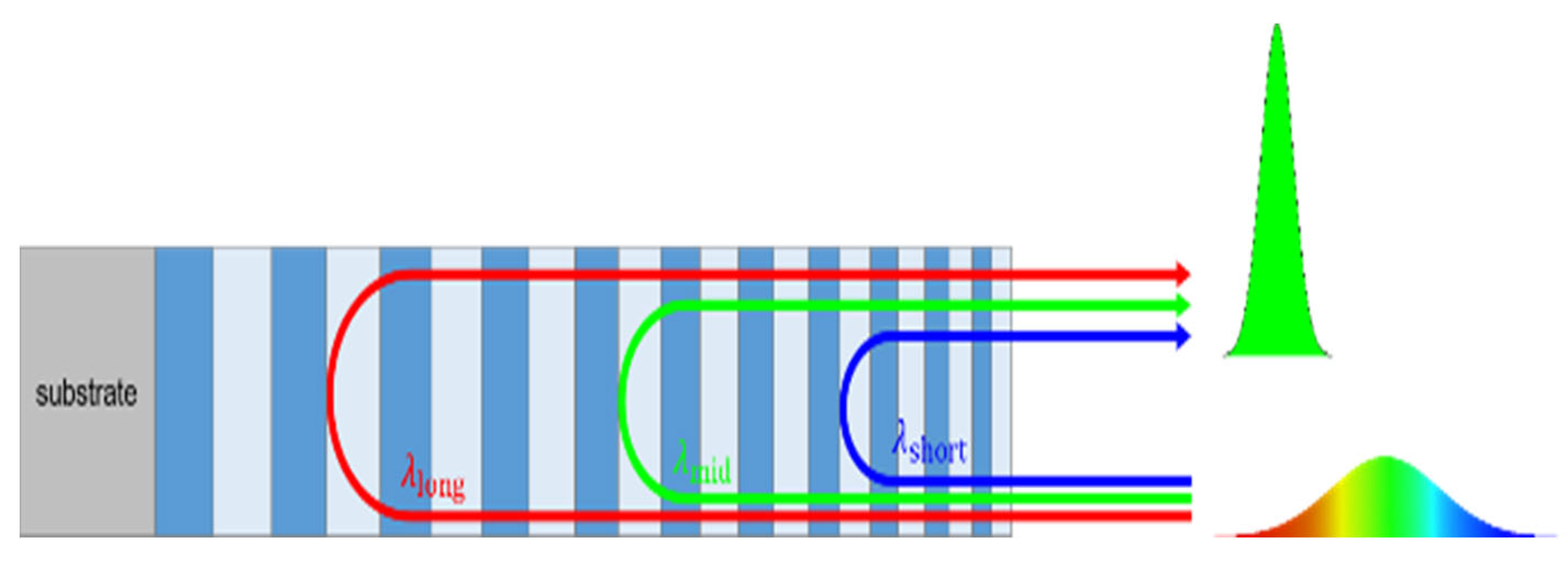
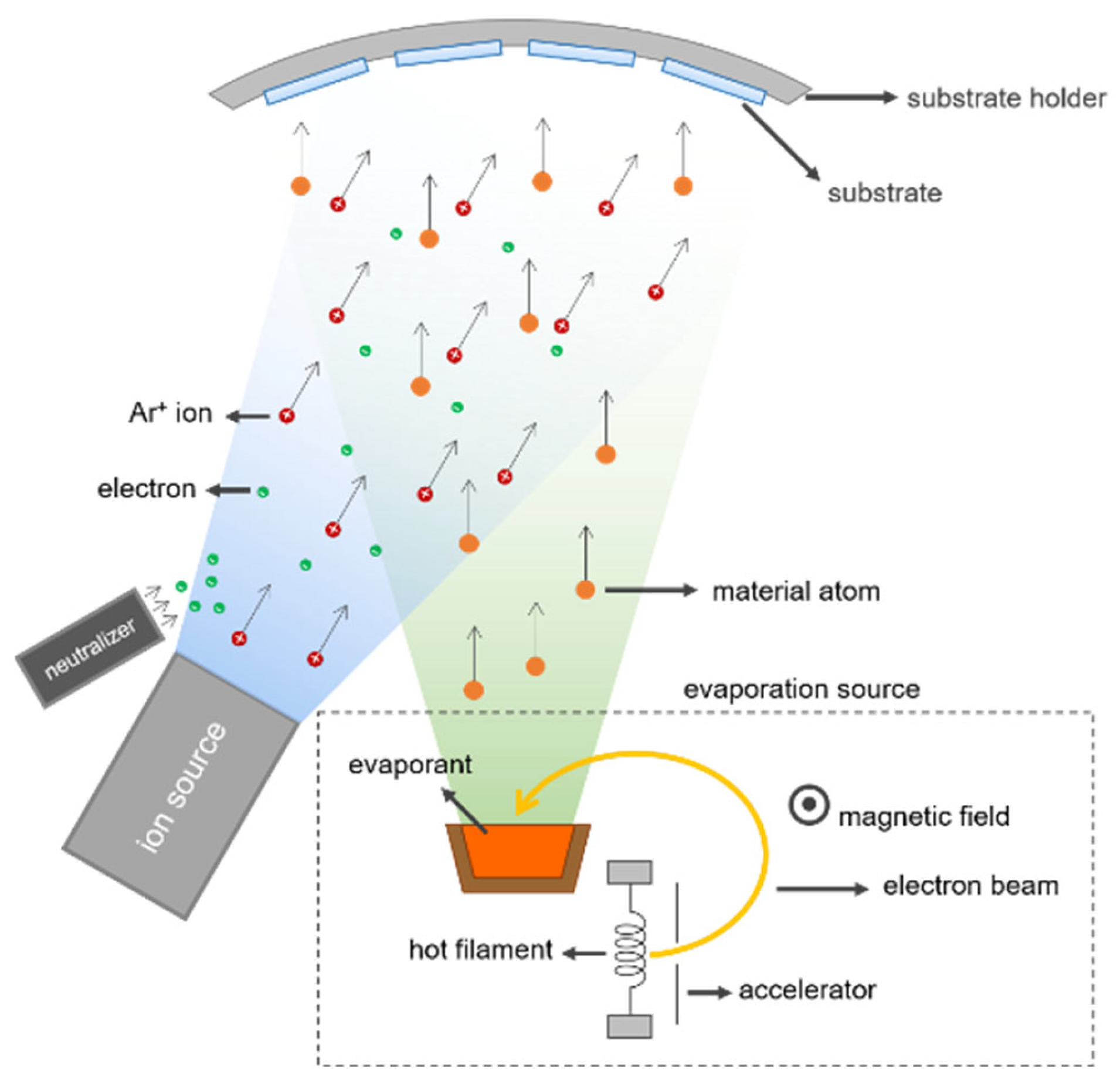
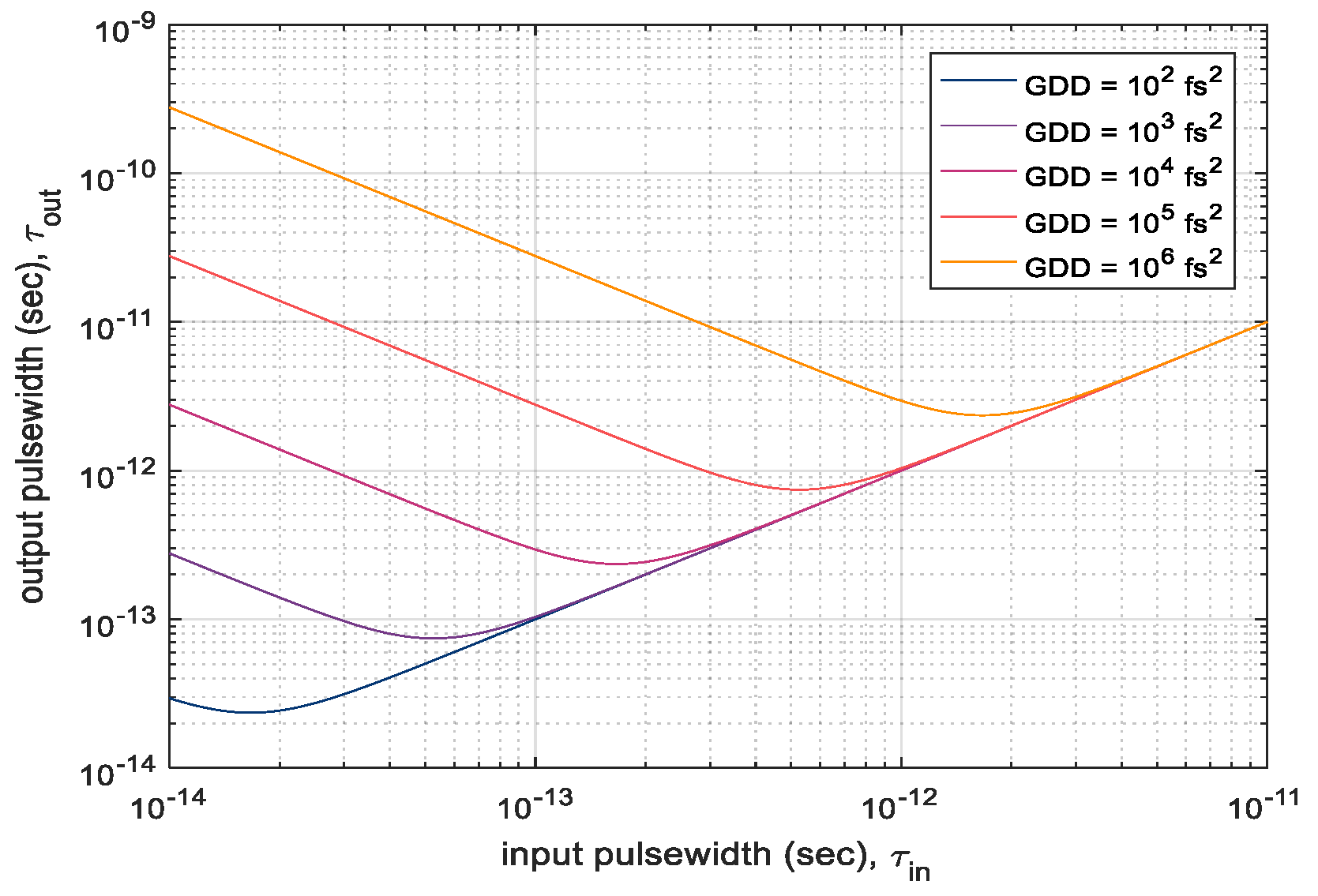
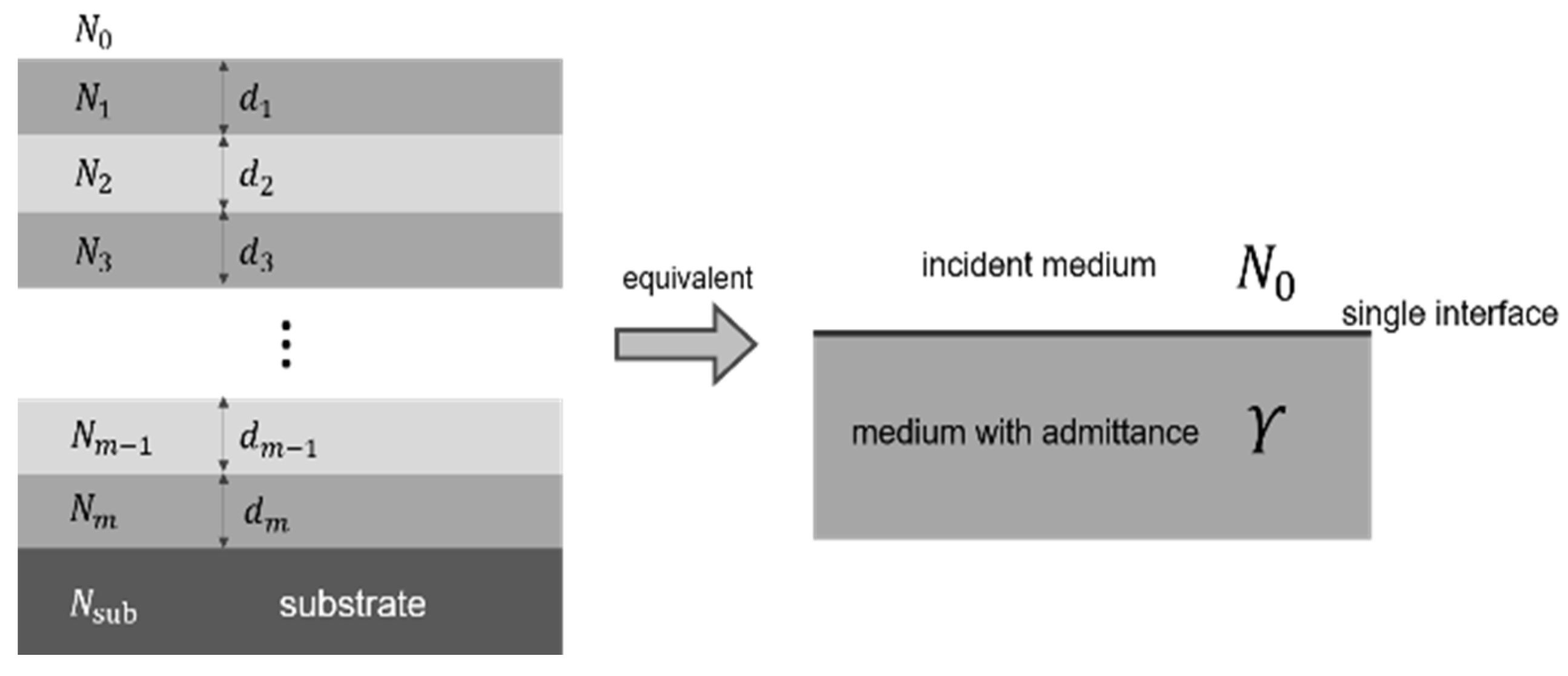


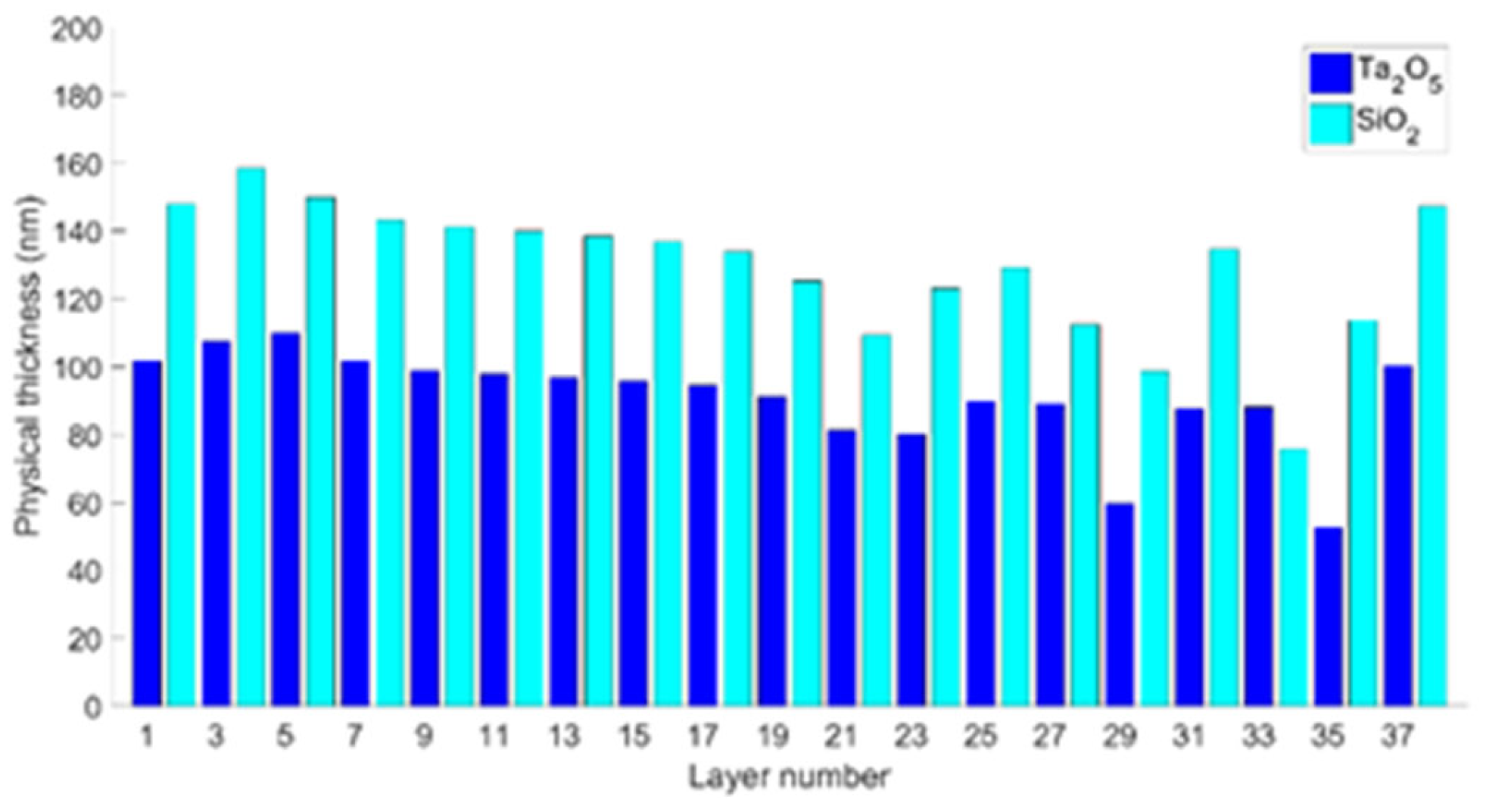
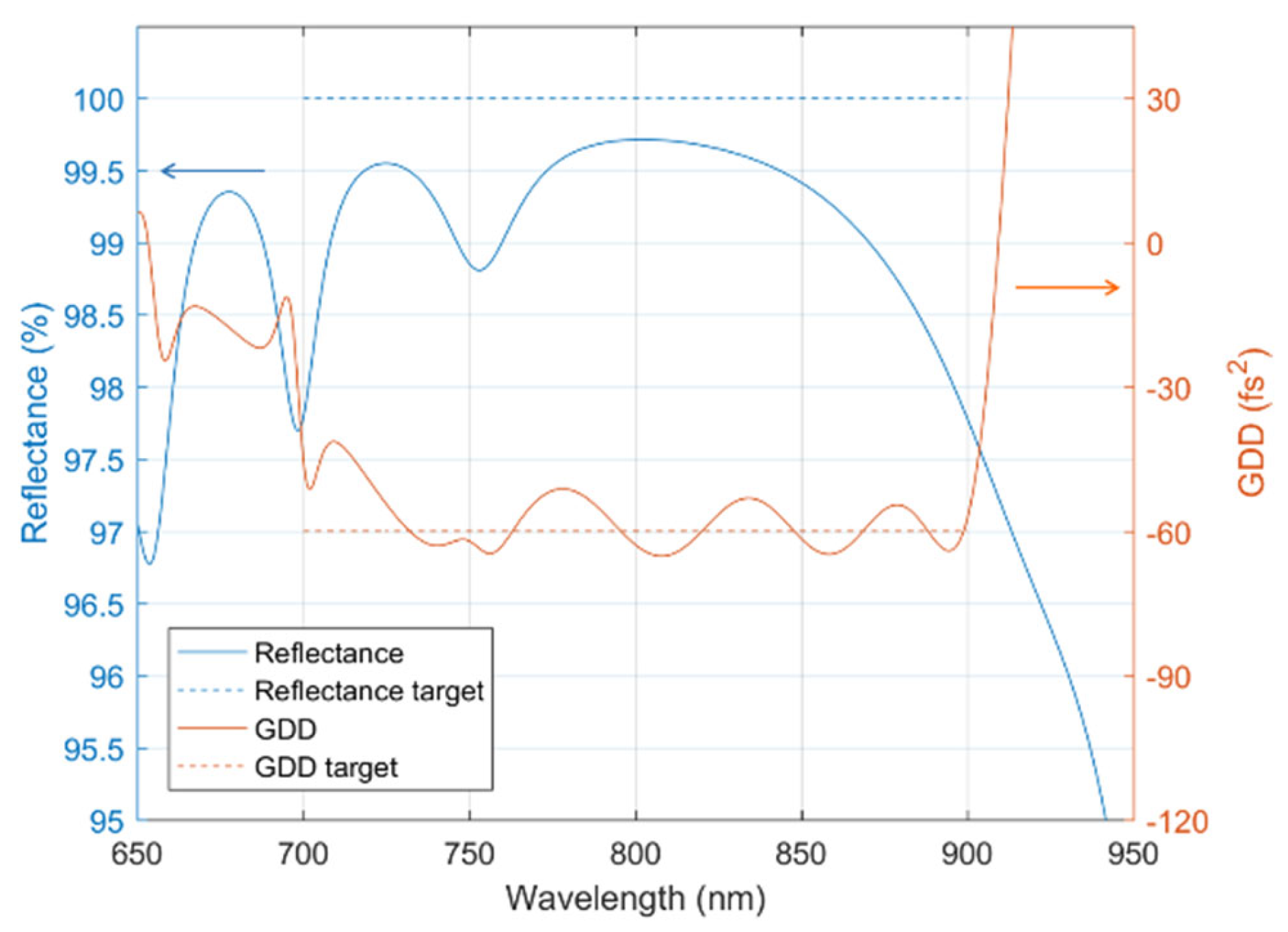
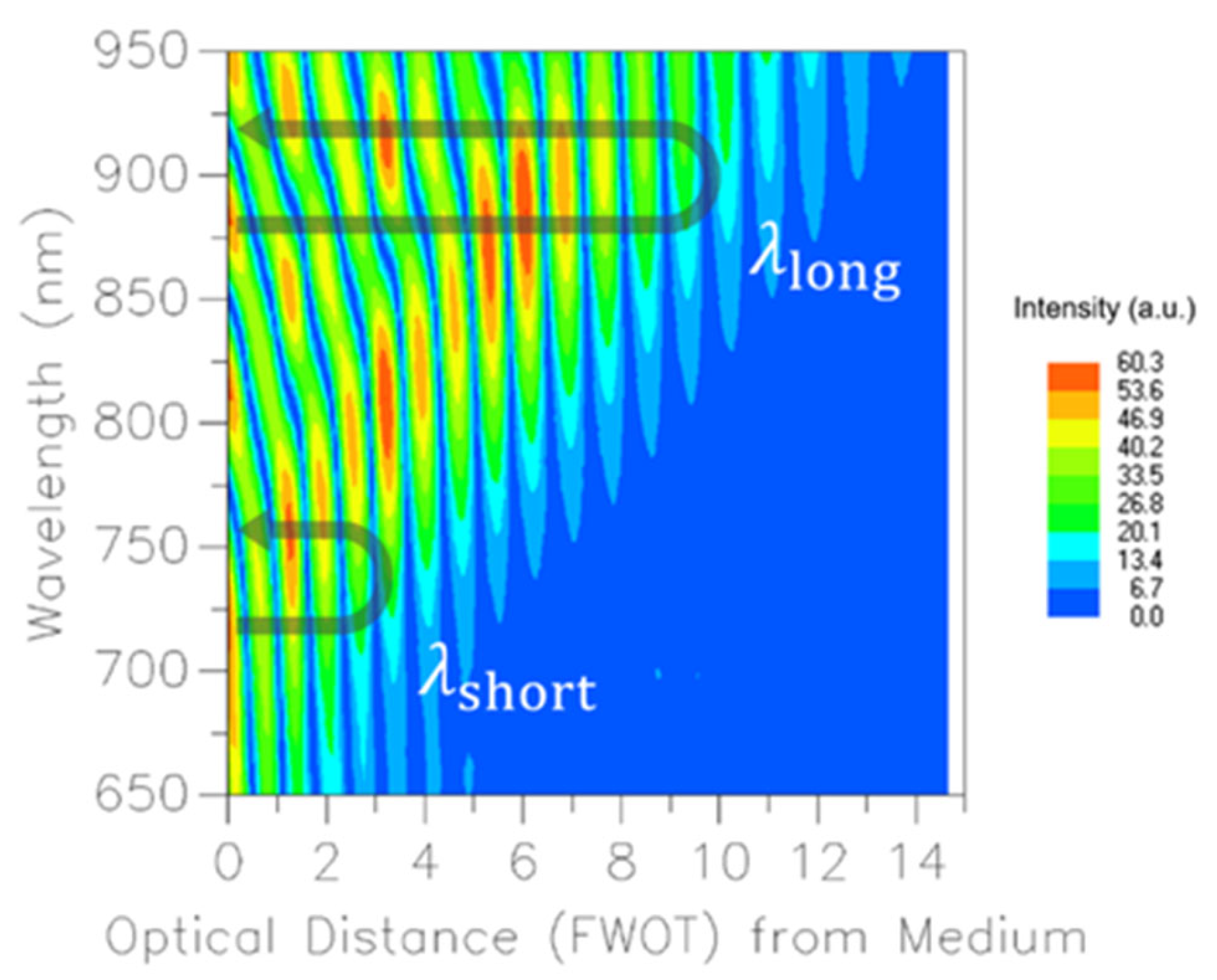
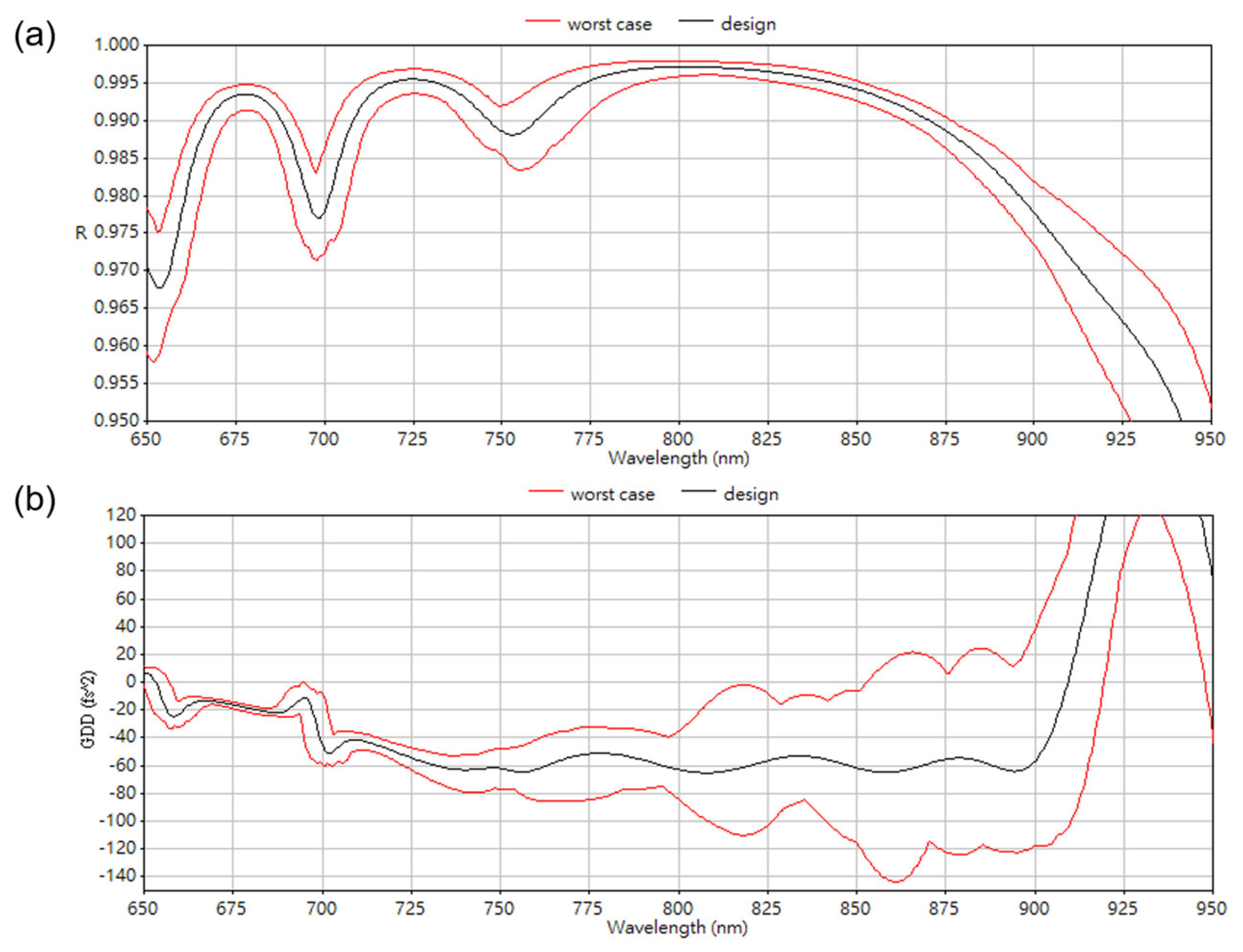
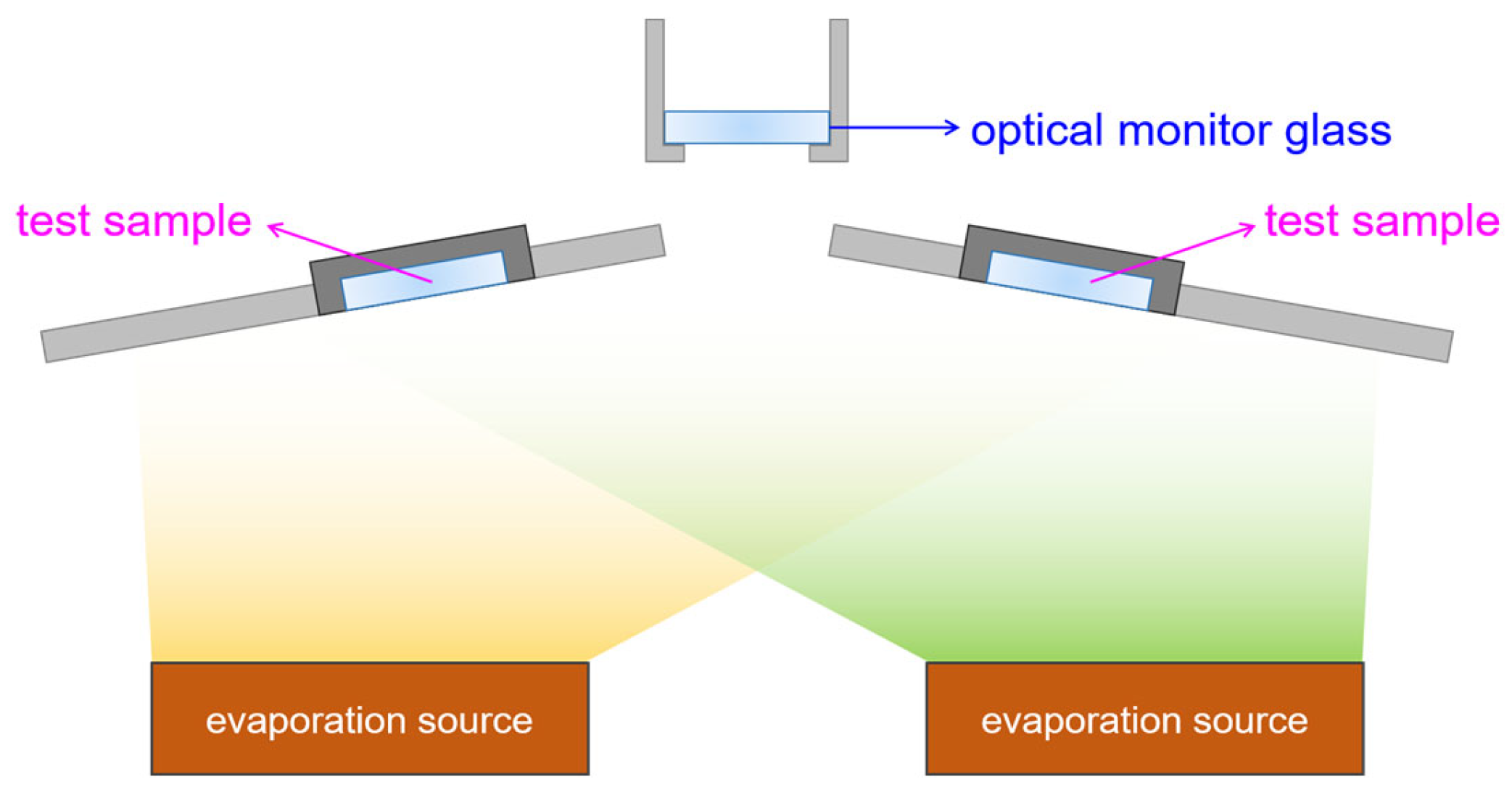
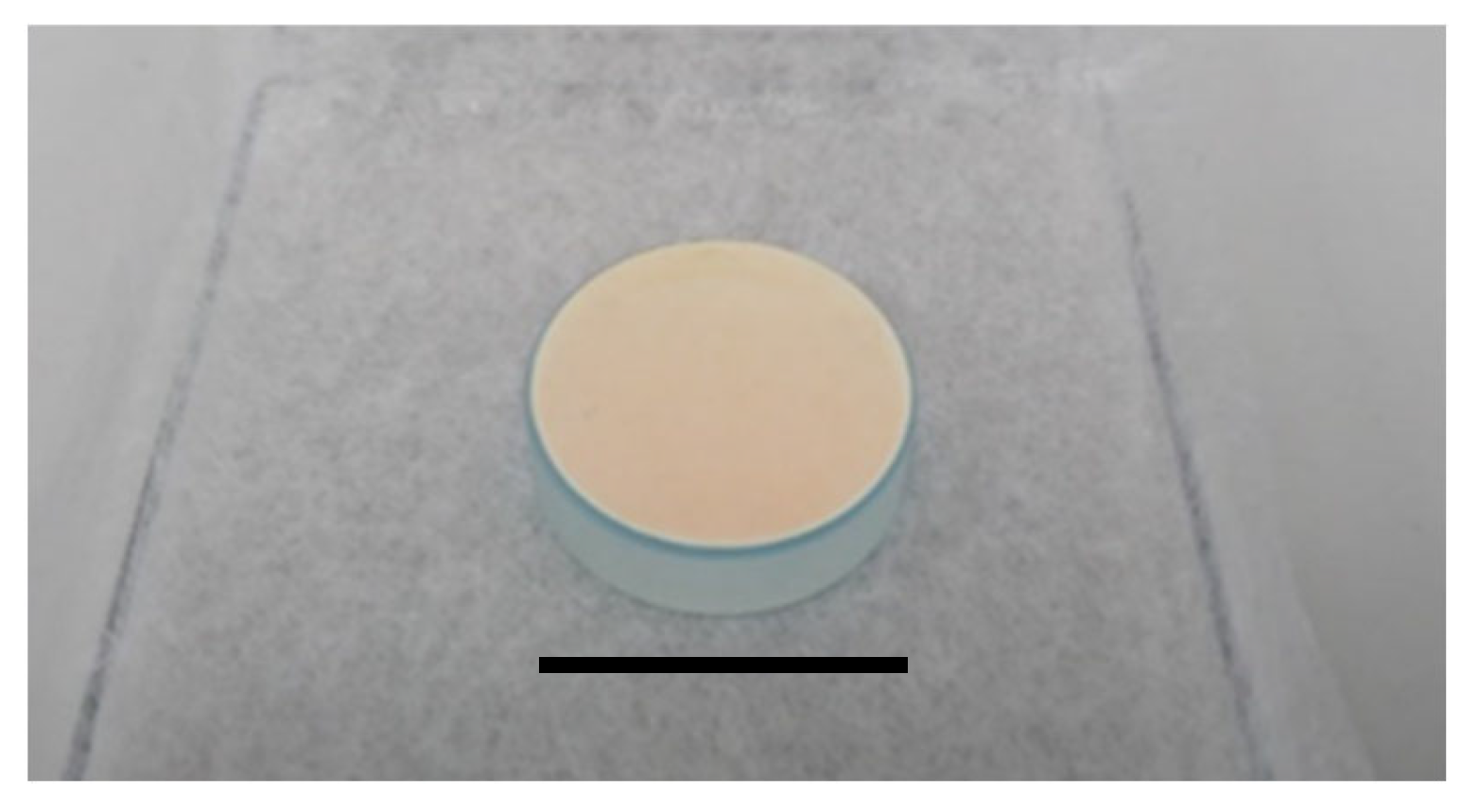
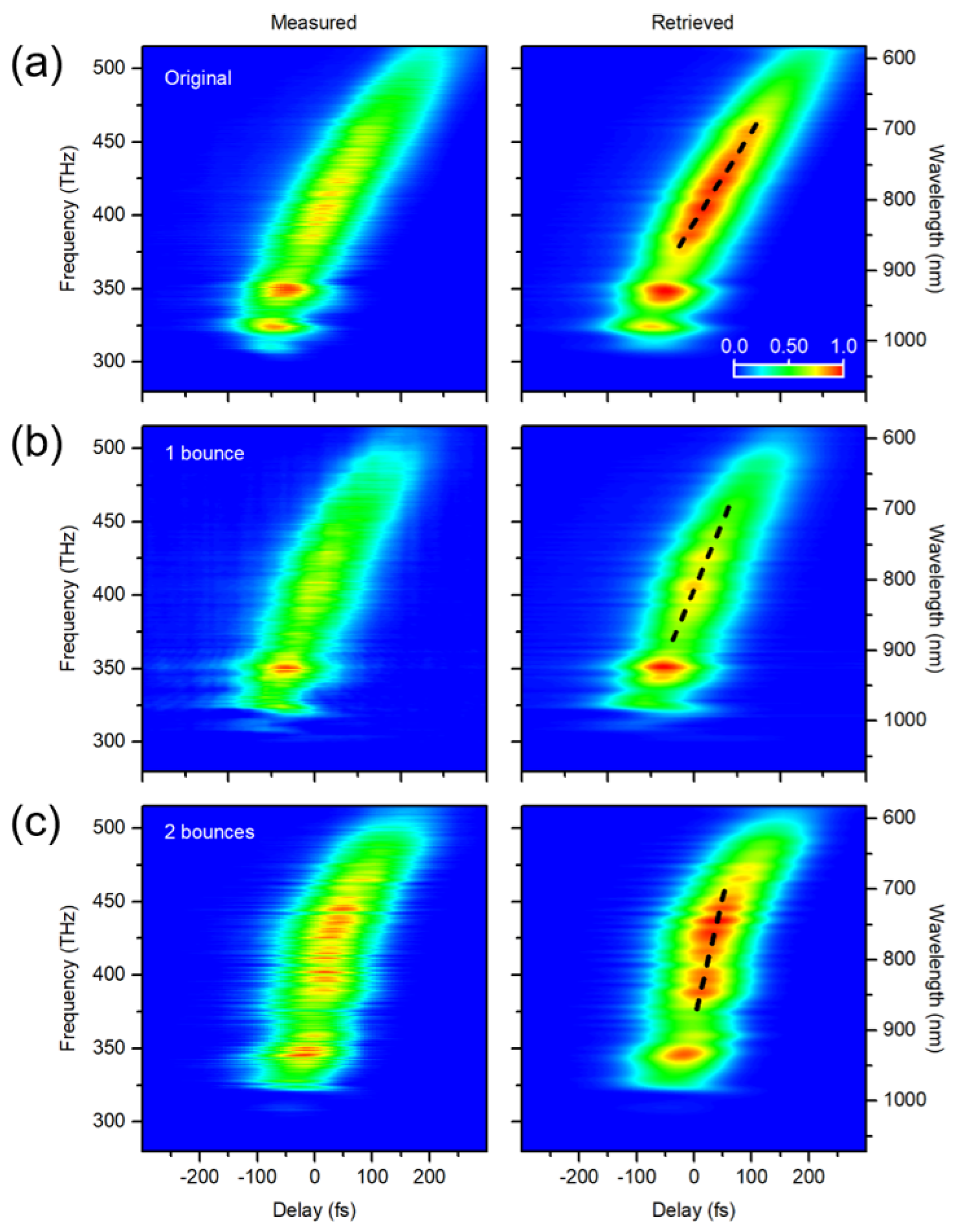

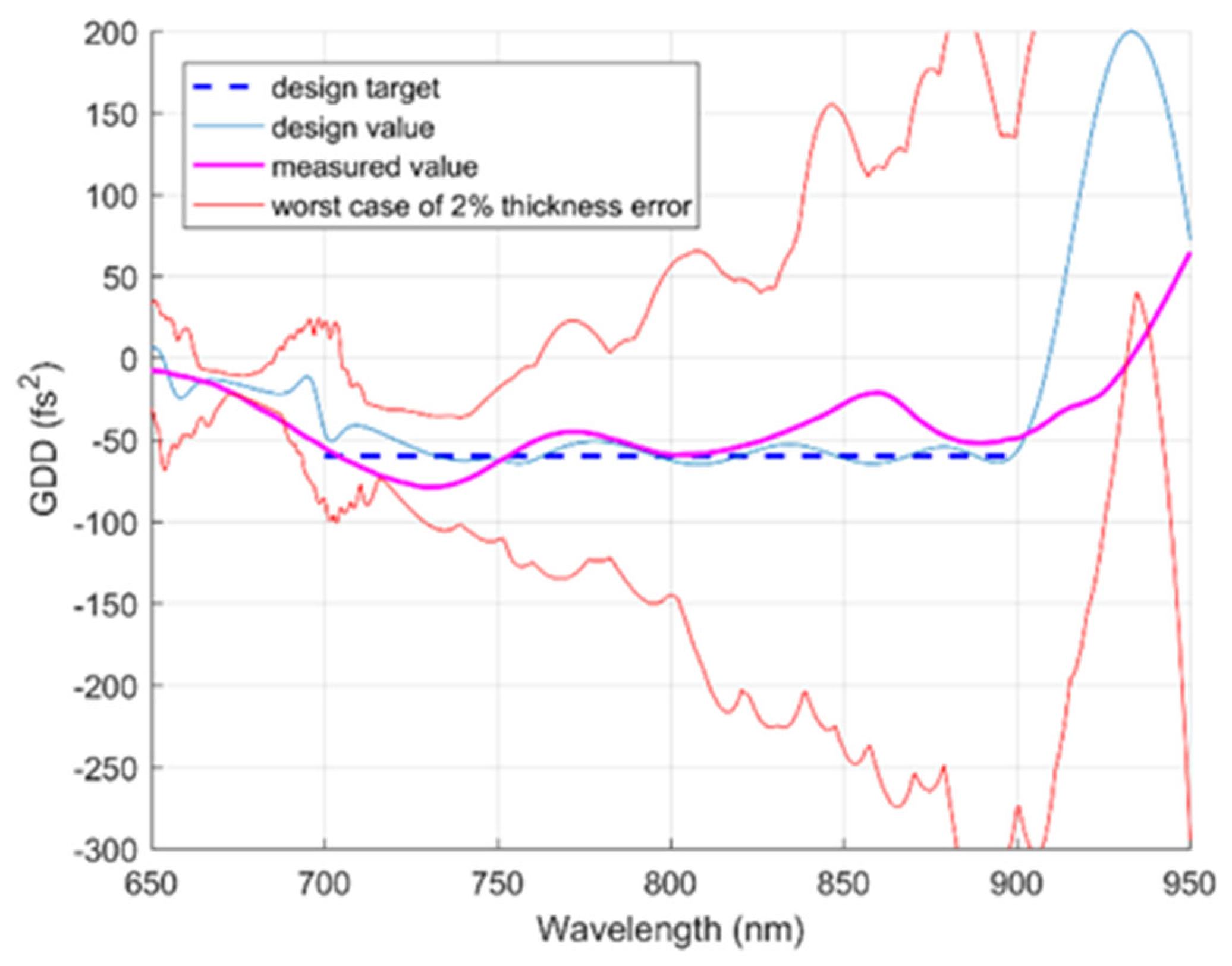
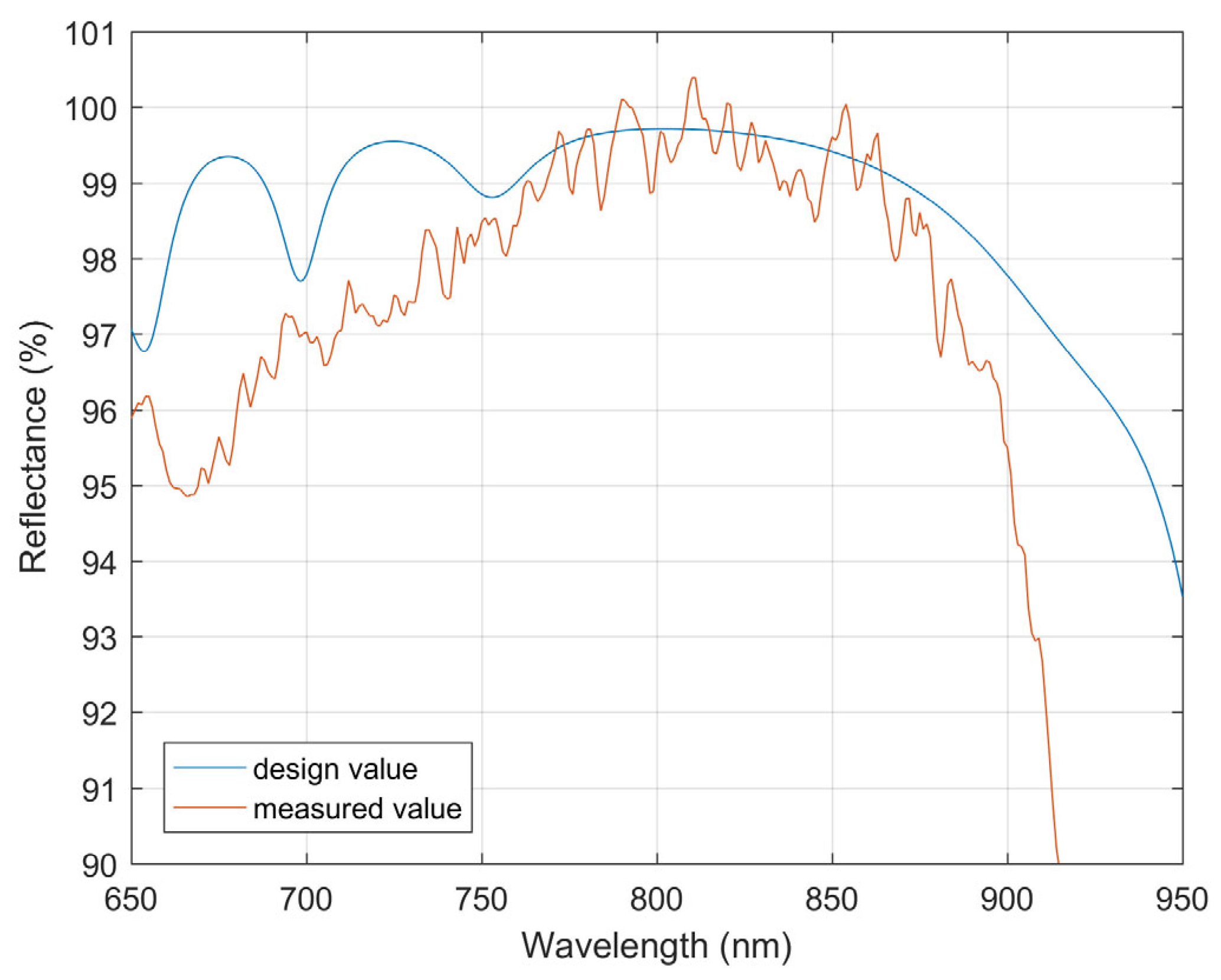
| Film Materials | Ta2O5 | SiO2 |
|---|---|---|
| Substrate Temperature (°C) | 200 | 200 |
| Starting Pressure (Pa) | 1 × 10−3 | 1 × 10−3 |
| E-gun Power (%) | 13 | 5.5 |
| Crystal Monitor Deposition Rate (nm/s) | 0.15 | 0.3 |
| Ion Source Gas Flow | Ar: 0 sccm O2: 25 sccm | Ar: 20 sccm O2: 0 sccm |
| Ion Source Anode Voltage (V) | 150 | 150 |
| Thickness Settings (nm) | 10.0 | 50.0 | 100.0 |
| Average Film Thickness (nm) | 13.22 | 45.77 | 95.65 |
| Monitored Glass Film Thickness (nm) | 12.51 | 41.56 | 84.76 |
| Tooling Factor (AFT/MGFT) | 1.0569 | 1.1012 | 1.1285 |
| Standard Deviation of 8 Samples (nm) | 0.25 | 0.58 | 0.23 |
| Thickness Settings (nm) | 10.0 | 50.0 | 100.0 |
| Average Film Thickness (nm) | 13.44 | 55.76 | 91.65 |
| Monitored Glass Film Thickness (nm) | 13.94 | 42.18 | 72.11 |
| Tooling Factor (AFT/MGFT) | 0.964 | 1.322 | 1.271 |
| Standard Deviation of 8 Samples (nm) | 0.19 | 0.88 | 0.75 |
Disclaimer/Publisher’s Note: The statements, opinions and data contained in all publications are solely those of the individual author(s) and contributor(s) and not of MDPI and/or the editor(s). MDPI and/or the editor(s) disclaim responsibility for any injury to people or property resulting from any ideas, methods, instructions or products referred to in the content. |
© 2023 by the authors. Licensee MDPI, Basel, Switzerland. This article is an open access article distributed under the terms and conditions of the Creative Commons Attribution (CC BY) license (https://creativecommons.org/licenses/by/4.0/).
Share and Cite
Chen, Y.-L.; Wang, P.-J. Study of Ion-Assisted E-Beam Evaporation Coating Process on Chirped Mirrors. Coatings 2023, 13, 356. https://doi.org/10.3390/coatings13020356
Chen Y-L, Wang P-J. Study of Ion-Assisted E-Beam Evaporation Coating Process on Chirped Mirrors. Coatings. 2023; 13(2):356. https://doi.org/10.3390/coatings13020356
Chicago/Turabian StyleChen, Yu-Long, and Pei-Jen Wang. 2023. "Study of Ion-Assisted E-Beam Evaporation Coating Process on Chirped Mirrors" Coatings 13, no. 2: 356. https://doi.org/10.3390/coatings13020356
APA StyleChen, Y.-L., & Wang, P.-J. (2023). Study of Ion-Assisted E-Beam Evaporation Coating Process on Chirped Mirrors. Coatings, 13(2), 356. https://doi.org/10.3390/coatings13020356







